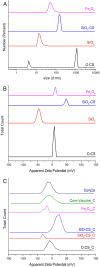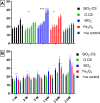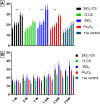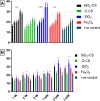Polymeric nanocarrier-based adjuvants to enhance a locally produced mucosal coryza vaccine in chicken
- PMID: 38961116
- PMCID: PMC11222434
- DOI: 10.1038/s41598-024-65267-y
Polymeric nanocarrier-based adjuvants to enhance a locally produced mucosal coryza vaccine in chicken
Abstract
Infectious coryza (IC) is an acute upper respiratory disease of chicken caused by Avibacterium (A.) paragallinarum. This disease results in an increased culling rate in meat chicken and a marked decrease in egg production (10% to more than 40%) in laying and breeding hens. Vaccines were first used against IC and effectively controlled the disease. Nanotechnology provides an excellent way to develop a new generation of vaccines. NPs have been widely used in vaccine design as adjuvants and antigen delivery vehicles and as antibacterial agents; thus, they can be used as inactivators for bacterial culture. In this research, the antibacterial effects of several nanoparticles (NPs), such as silicon dioxide with chitosan (SiO2-CS), oleoyl-chitosan (O.CS), silicon dioxide (SiO2), and iron oxide (Fe3O4), on A. paragallinarum were studied. Additionally, different A. paragallinarum vaccines were made using the same nanomaterials at a concentration of 400 µg/ml to help control infectious coryza disease in chicken. A concentration of 400 µg/ml of all the NPs tested was the best concentration for the inactivation of A. paragallinarum. Additionally, this study showed that the infectious coryza vaccine adjuvanted with SiO2 NPs had the highest immune response, followed by the infectious coryza vaccine adjuvanted with Fe3O4 NPs, the infectious coryza vaccine adjuvanted with SiO2-CS NPs, and the infectious coryza vaccine adjuvanted with O.CS NPs in comparison with the infectious coryza vaccine adjuvanted with liquid paraffin (a commercial vaccine).
Keywords: A. Paragallinarum; Infectious coryza; Iron oxide; Nanomaterials; Nanovaccine; Oleyl chitosan; Silicon dioxide.
© 2024. The Author(s).
Conflict of interest statement
The authors declare no competing interests.
Figures









Similar articles
-
Phoenix dactylifera, mentha piperita and montanide™ ISA-201 as immunological adjuvants in a chicken model.Acta Trop. 2020 Feb;202:105281. doi: 10.1016/j.actatropica.2019.105281. Epub 2019 Nov 21. Acta Trop. 2020. PMID: 31759920
-
Protection Conferred by Infectious Coryza Vaccines Against Emergent Avibacterium paragallinarum Serovar C-1.Avian Dis. 2015 Mar;59(1):162-4. doi: 10.1637/10926-082814-resnote. Avian Dis. 2015. PMID: 26292552 Clinical Trial.
-
Characterization of emergent Avibacterium paragallinarum strains and the protection conferred by infectious coryza vaccines against them in China.Poult Sci. 2019 Dec 1;98(12):6463-6471. doi: 10.3382/ps/pez531. Poult Sci. 2019. PMID: 31801310 Free PMC article.
-
Infectious coryza: overview of the disease and new diagnostic options.Clin Microbiol Rev. 1999 Oct;12(4):627-32. doi: 10.1128/CMR.12.4.627. Clin Microbiol Rev. 1999. PMID: 10515906 Free PMC article. Review.
-
Chitosan Nanoparticle Based Mucosal Vaccines Delivered Against Infectious Diseases of Poultry and Pigs.Front Bioeng Biotechnol. 2020 Nov 13;8:558349. doi: 10.3389/fbioe.2020.558349. eCollection 2020. Front Bioeng Biotechnol. 2020. PMID: 33282847 Free PMC article. Review.
Cited by
-
Chitosan and carboxymethyl chitosan nanocarriers enhance mango seed extract stability and antimicrobial activity to improve strawberry postharvest quality.Sci Rep. 2025 Aug 26;15(1):31384. doi: 10.1038/s41598-025-16756-1. Sci Rep. 2025. PMID: 40858703 Free PMC article.
References
-
- Blackall PJ, Christensen H, Beckenham T, Blackall LL, Bisgaard M. Reclassification of Pasteurella gallinarum, [Haemophilus] paragallinarum, Pasteurella avium and Pasteurella volantium as Avibacterium gallinarum gen. nov., comb. nov., Avibacterium paragallinarum comb. nov., Avibacterium avium comb. nov. and Avibacterium. Int. J. Syst. Evol. Microbiol. 2005;55:353–362. doi: 10.1099/ijs.0.63357-0. - DOI - PubMed
MeSH terms
Substances
LinkOut - more resources
Full Text Sources

